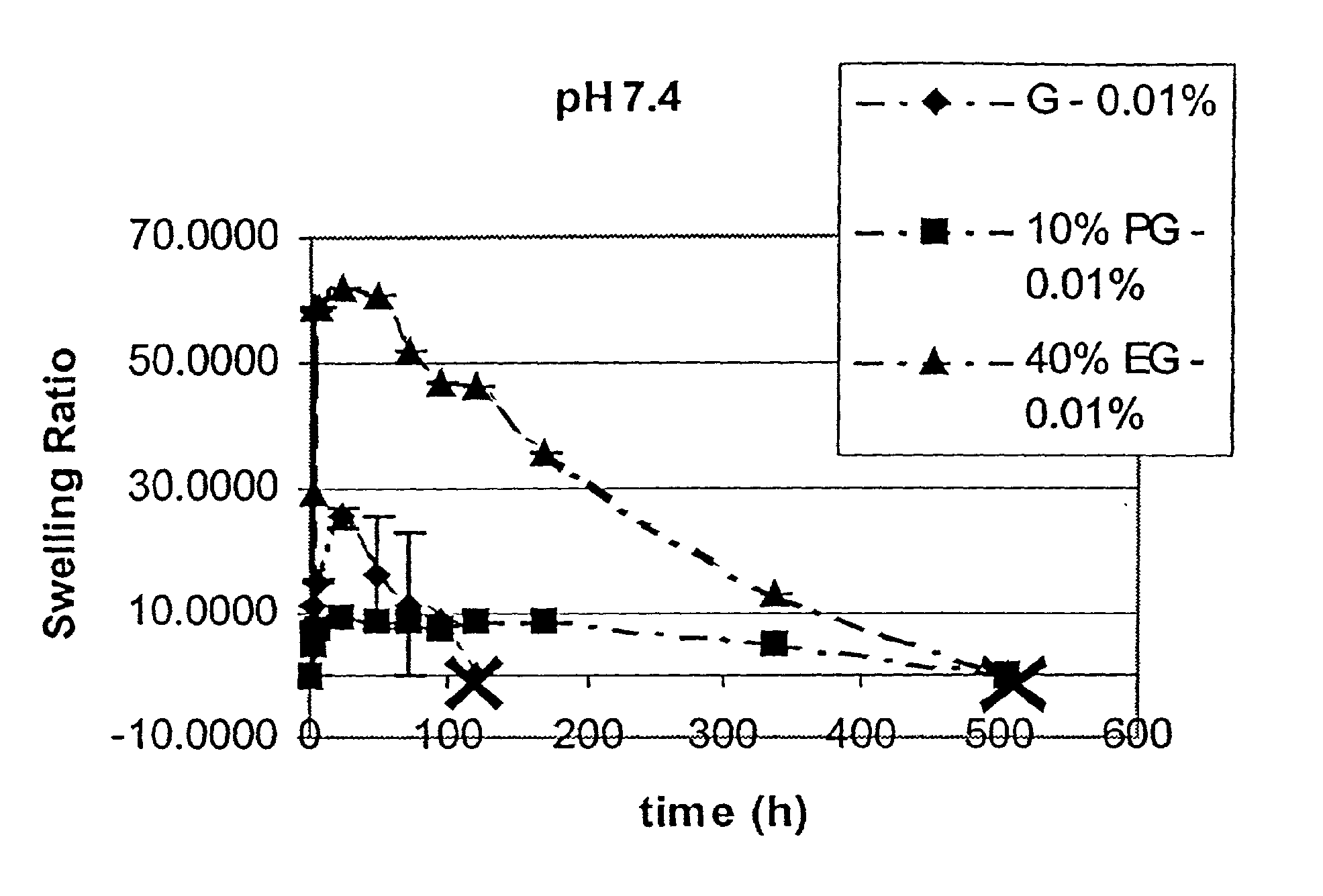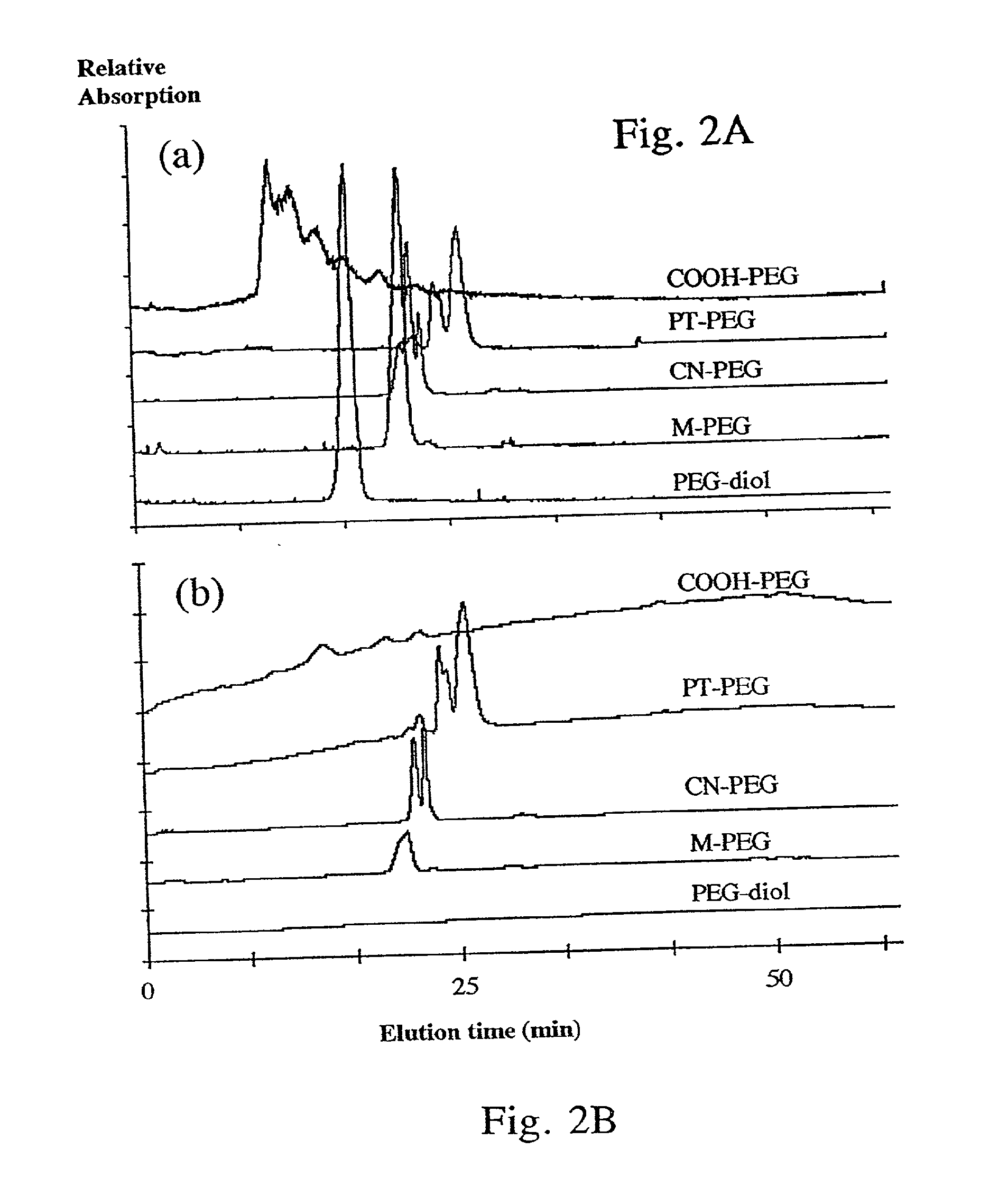Bifunctional-modified hydrogels
a technology of hydrogels and bifunctional molecules, applied in the field of hydrogels, can solve the problems of limited efficacy of current materials used in the construction of biomedical devices, multi-functional structures, and dressings that do not address, so as to facilitate gas exchange, prevent swelling of wound beds, maintain humidity and oxygen levels
- Summary
- Abstract
- Description
- Claims
- Application Information
AI Technical Summary
Benefits of technology
Problems solved by technology
Method used
Image
Examples
example 1
Synthesis and Characterization of Heterobifunctional PEGs
[0149]All reagents were purchased from Sigma-Aldrich (St. Louis, Mo.) unless stated otherwise. A summary of the chemical reactions and structure of critical intermediates and final products is presented in FIG. 1.
[0150]To synthesize α-methyl-ω-acrylate PEGs (M-PEG), monomethoxy PEGs (2 kDa or 5 kDa, purchased from Fluka, a division of Sigma-Aldrich) were dissolved in dry tetrahydrofuran (THF) solution followed by the addition of triethylamine (TEA, 2 eq.) and acryloyl chloride (AC, 4 eq.) (14) at room temperature under Ar for 10 min, filtered, dried by rotary evaporation, re-dissolved in CH2Cl2, and precipitated in cold hexane. The final product was filtered, dried, and stored in vacuo at room temperature.
[0151]To synthesize α-cyanoethyl-ω-acrylate-PEGs (CN-PEG), PEG-diols (2 kDa or 5 kDa) (1 eq.) were dissolved in dry CH2Cl2 solution followed by the addition of fine sodium metal (2 eq.) stirred for 12 hr at room temperature. ...
example 2
[0171]This Example explores the swelling and drug release kinetics of various gelatin-based hydrogels. The hydrogels were cross-linked by various means, and contained various modifications of the gelatin backbone. The effect of pH on the drug release kinetics of these gels was also investigated.
[0172]As noted above, cross-linking gelatin produces a hydrogel of high molecular weight and reduces or prevents gelatin dissolution. The cross-linking agents used in this Example were: 0.1%, 0.01%, and 0.001% (v / v) glutaraldehyde aqueous solutions, and self-cross-linking via liquid nitrogen immersion followed by baking. The backbone modifications to the gelatin were the addition of polyethylene glycol (PEG) or ethylenediaminetetraacetic dianhydride (EDTAD) or both. PEG has low immunogenicity and cytotoxicity. EDTAD has low toxicity and the lysyl residues of gelatin can be modified with EDTAD in a relatively fast reaction following facile procedures. See Hwang & Damodaran...
example 3
In Vivo Modulation of Host Response Using Gels Grafted with Fibronectin-Derived Biomimetic Oligopeptides
[0183]The host inflammatory reaction is a normal response to injury and the presence of foreign objects. The magnitude and duration of the inflammatory process have a direct impact on biomaterial biostability and biocompatability. Thus, this Example investigates the performance of gels fabricated according to the present invention that include fibronectin-derived biomimetic oligopeptides. Fibronectin in known to adsorb on a variety of biomaterials and play an important role in the host-foreign body reaction. The RGD (SEQ. ID. NO: 1) and PHSRN (SEQ. ID. NO: 2) amino acid sequences are particularly interesting because these sequences are present on adjacent loops of two connecting FIII modules and bind synergistically to a host of integrins.
[0184]Oligopeptides were designed based on the primary and tertiary structure of human plasma fibronectin to study the structure-functional rela...
PUM
 Login to View More
Login to View More Abstract
Description
Claims
Application Information
 Login to View More
Login to View More - R&D
- Intellectual Property
- Life Sciences
- Materials
- Tech Scout
- Unparalleled Data Quality
- Higher Quality Content
- 60% Fewer Hallucinations
Browse by: Latest US Patents, China's latest patents, Technical Efficacy Thesaurus, Application Domain, Technology Topic, Popular Technical Reports.
© 2025 PatSnap. All rights reserved.Legal|Privacy policy|Modern Slavery Act Transparency Statement|Sitemap|About US| Contact US: help@patsnap.com



